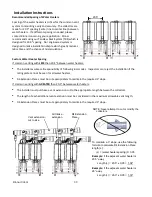
19
Rinnai CVent
Combustion Air Requirements (
Commercial Applications with C199i Only
)
Common Vent Applications Utilizing Room Air
Only the C199i (REU-KBD3237FFUDC-US) tankless water heater is certified to utilize room air in
commercial applications using Rinnai Common Vent System.
Common Vent Room Air
Appliance Adapter
Combustion Air Requirements
This rack system requires adequate combustion air for ventilation and dilution of flue gases. Failure to
provide adequate combustion air can result in unit failure, fire, explosion, serious bodily injury or death.
Use the following methods to ensure adequate combustion air is available for correct and safe
operation of this rack system.
Important: Combustion air must be free of corrosive chemicals. Do not provide combustion air from
corrosive environments. System failure due to corrosive air is not covered by warranty.
Combustion air must be free of acid forming chemical such as sulfur, fluorine and chlorine. These
chemicals have been found to cause rapid damage and decay and can become toxic when used as
combustion air in gas appliances. Such chemicals can be found in, but not limited to bleach, ammonia,
cat litter, aerosol sprays, cleaning solvents, varnish, paint and air fresheners. Do not store these
products or similar products in the vicinity of the water heater system.
Unconfined Space:
An unconfined space is defined in
National Fuel Gas Code, ANSI Z223.1/NFPA 54
as “a space whose
volume is not less than 50 cubic feet per 1000 Btu/hr (4.8 m3 per kW per hour) of the aggregate input
rating of all appliances installed in that space. Rooms communicating directly with the space in which
the appliances are installed, through openings not furnished with doors, are considered a part of the
unconfined space.” If the “unconfined space” containing the system is in a building with tight
construction, additional outside air may be required for proper operation. Outside air openings should
be sized the same as for a confined space.
Confined Space:
(Small Room, Closet, Alcove, Utility Room, Etc.)
A confined space is defined in the
National Fuel Gas Code, ANSI Z223.1/NFPA 54
as "a space whose
volume is less than 50 cubic feet per 1000 Btu/hr (4.8 m3 per kW per hour) of the aggregate input rating
of the combined appliances installed in that space." A confined space must have two combustion air
openings. Size the combustion air openings based on the BTU input for all gas utilization equipment in
the space and the method by which combustion air is supplied.
Summary of Contents for c199i
Page 43: ...43 Rinnai CVent NOTES ...
Page 86: ...86 CVent de Rinnai NOTES ...
Page 87: ...87 CVent de Rinnai NOTES ...
















































